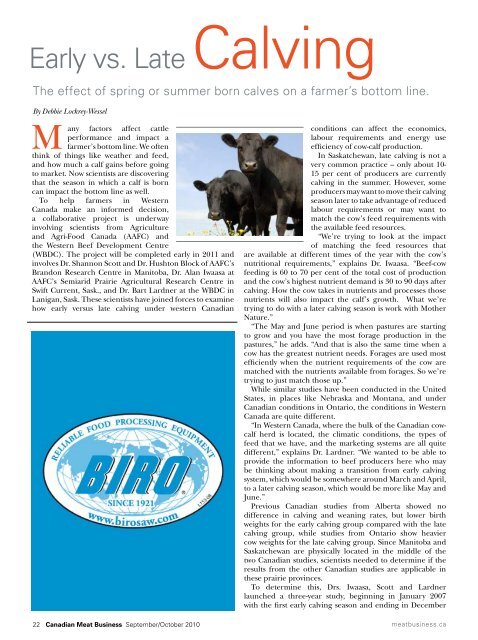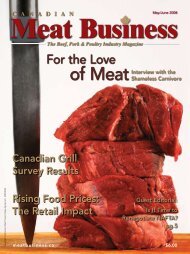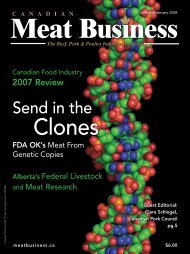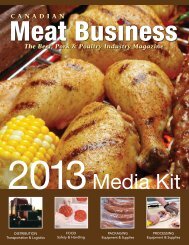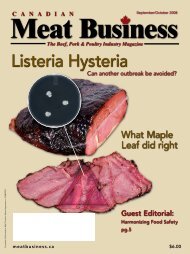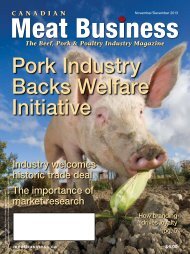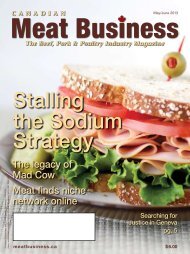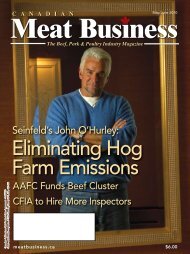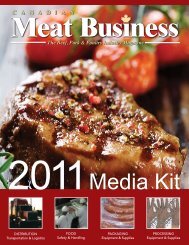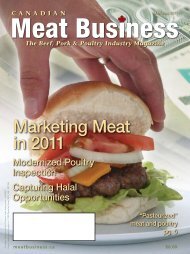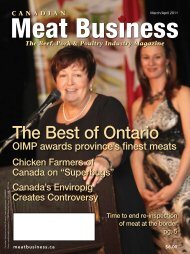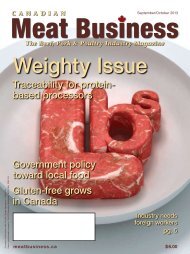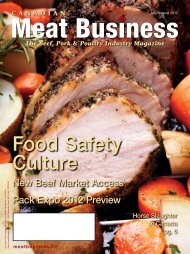Ralph Cator
Joining Meat Hall's Class of 2010 - Canadian Meat Business
Joining Meat Hall's Class of 2010 - Canadian Meat Business
You also want an ePaper? Increase the reach of your titles
YUMPU automatically turns print PDFs into web optimized ePapers that Google loves.
Early vs. LateCalving<br />
The effect of spring or summer born calves on a farmer’s bottom line.<br />
By Debbie Lockrey-Wessel<br />
M<br />
any factors affect cattle<br />
performance and impact a<br />
farmer’s bottom line. We often<br />
think of things like weather and feed,<br />
and how much a calf gains before going<br />
to market. Now scientists are discovering<br />
that the season in which a calf is born<br />
can impact the bottom line as well.<br />
To help farmers in Western<br />
Canada make an informed decision,<br />
a collaborative project is underway<br />
involving scientists from Agriculture<br />
and Agri-Food Canada (AAFC) and<br />
the Western Beef Development Centre<br />
(WBDC). The project will be completed early in 2011 and<br />
involves Dr. Shannon Scott and Dr. Hushton Block of AAFC’s<br />
Brandon Research Centre in Manitoba, Dr. Alan Iwaasa at<br />
AAFC’s Semiarid Prairie Agricultural Research Centre in<br />
Swift Current, Sask., and Dr. Bart Lardner at the WBDC in<br />
Lanigan, Sask. These scientists have joined forces to examine<br />
how early versus late calving under western Canadian<br />
conditions can affect the economics,<br />
labour requirements and energy use<br />
efficiency of cow-calf production.<br />
In Saskatchewan, late calving is not a<br />
very common practice – only about 10-<br />
15 per cent of producers are currently<br />
calving in the summer. However, some<br />
producers may want to move their calving<br />
season later to take advantage of reduced<br />
labour requirements or may want to<br />
match the cow’s feed requirements with<br />
the available feed resources.<br />
“We’re trying to look at the impact<br />
of matching the feed resources that<br />
are available at different times of the year with the cow’s<br />
nutritional requirements,” explains Dr. Iwaasa. “Beef-cow<br />
feeding is 60 to 70 per cent of the total cost of production<br />
and the cow’s highest nutrient demand is 30 to 90 days after<br />
calving. How the cow takes in nutrients and processes those<br />
nutrients will also impact the calf’s growth. What we’re<br />
trying to do with a later calving season is work with Mother<br />
Nature.”<br />
“The May and June period is when pastures are starting<br />
to grow and you have the most forage production in the<br />
pastures,” he adds. “And that is also the same time when a<br />
cow has the greatest nutrient needs. Forages are used most<br />
efficiently when the nutrient requirements of the cow are<br />
matched with the nutrients available from forages. So we’re<br />
trying to just match those up.”<br />
While similar studies have been conducted in the United<br />
States, in places like Nebraska and Montana, and under<br />
Canadian conditions in Ontario, the conditions in Western<br />
Canada are quite different.<br />
“In Western Canada, where the bulk of the Canadian cowcalf<br />
herd is located, the climatic conditions, the types of<br />
feed that we have, and the marketing systems are all quite<br />
different,” explains Dr. Lardner. “We wanted to be able to<br />
provide the information to beef producers here who may<br />
be thinking about making a transition from early calving<br />
system, which would be somewhere around March and April,<br />
to a later calving season, which would be more like May and<br />
June.”<br />
Previous Canadian studies from Alberta showed no<br />
difference in calving and weaning rates, but lower birth<br />
weights for the early calving group compared with the late<br />
calving group, while studies from Ontario show heavier<br />
cow weights for the late calving group. Since Manitoba and<br />
Saskatchewan are physically located in the middle of the<br />
two Canadian studies, scientists needed to determine if the<br />
results from the other Canadian studies are applicable in<br />
these prairie provinces.<br />
To determine this, Drs. Iwaasa, Scott and Lardner<br />
launched a three-year study, beginning in January 2007<br />
with the first early calving season and ending in December<br />
22 Canadian Meat Business September/October 2010 meatbusiness.ca


